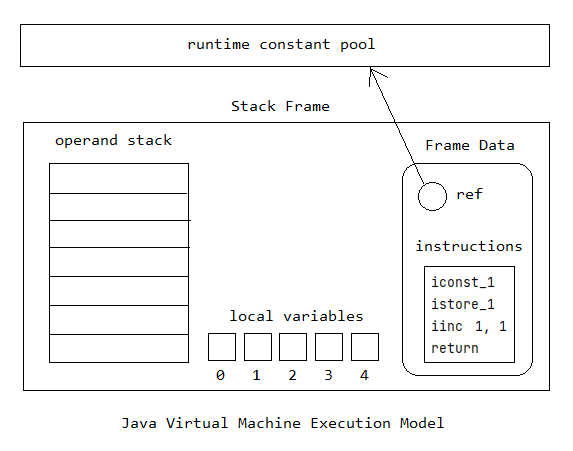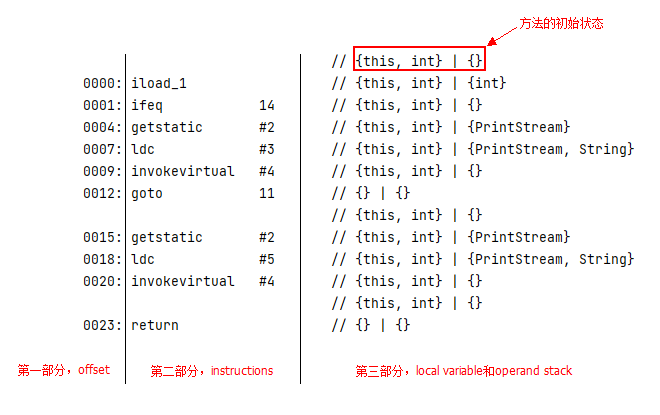Execution Model
什么是 Execution Model
在asm4-guide.pdf文档的 3.1.1. Execution Model 部分提到了 Execution Model。
那么,Execution Model 是什么呢? 其实,Execution Model 就是指 Stack Frame 简化之后的模型。 如何“简化”呢?也就是,我们不需要去考虑 Stack Frame 的技术实现细节,把它想像一个理想的模型就可以了。
针对 Execution Model 或 Stack Frame,我们可以理解成它由 local variable 和 operand stack 两个部分组成。 或者说,理解成:它由 local variable、operand stack 和 frame data 三个部分组成。 换句话说,local variable 和 operand stack 是两个必不可少的部分,而 frame data 是一个相对来说不那么重要的部分。 在一般的描述当中,都是将 Stack Frame 描述成 local variable 和 operand stack 两个部分; 但是,如果我们为了知识的完整性,就可以考虑添加上 frame data 这个部分。

另外,方法的执行与 Stack Frame 之间有一个非常紧密的关系:
- 一个方法的调用开始,就对应着 Stack Frame 的内存空间的分配。
- 一个方法的执行结束,无论正常结束(return),还是异常退出(throw exception),都表示着相应的 Stack Frame 内存空间被销毁。
接下来,我们就通过两个方面来把握 Stack Frame 的状态:
- 第一个方面,方法刚进入的时候,任何的 instruction 都没有执行,那么 Stack Frame 是一个什么样的状态呢?
- 第二个方面,在方法开始执行后,这个时候 instruction 开始执行,每一条 instruction 的执行,会对 Stack Frame 的状态产生什么样的影响呢?
方法的初始状态
在方法进入的时候,会生成相应的 Stack Frame 内存空间。那么,Stack Frame 的初始状态是什么样的呢?
在 Stack Frame 当中,operand stack 是空的,而 local variables 则需要考虑三方面的因素:
- 当前方法是否为 static 方法。
- 如果当前方法是 non-static 方法,则需要在 local variables 索引为
0的位置存在一个this变量,后续的内容从1开始存放。 - 如果当前方法是 static 方法,则不需要存储
this,因此后续的内容从0开始存放。
- 如果当前方法是 non-static 方法,则需要在 local variables 索引为
- 当前方法是否接收参数。方法接收的参数,会按照参数的声明顺序放到 local variables 当中。
-
方法参数是否包含
long或double类型。如果方法的参数是long或double类型,那么它在 local variables 当中占用两个位置。 - 问题:能否在文档中找到依据呢?
- 回答:能。
The Java Virtual Machine uses local variables to pass parameters on method invocation.
On class method invocation,
any parameters are passed in consecutive local variables starting from local variable 0.
On instance method invocation, local variable 0 is always used to pass a reference to the object
on which the instance method is being invoked (this in the Java programming language).
Any parameters are subsequently passed in consecutive local variables starting from local variable 1.
(内容来自于2.6.1. Local Variables)
The operand stack is empty when the frame that contains it is created. (内容来自于2.6.2. Operand Stacks)
方法的后续变化
方法的后续变化,就是在方法初始状态的基础上,随着 instruction 的执行而对 local variable 和 operand stack 的状态产生影响。
当方法执行时,就是将 instruction 一条一条的执行:
- 第一步,获取 instruction。每一条 instruction 都是从
instructions内存空间中取出来的。 - 第二步,执行 instruction。对于 instruction 的执行,就会引起 operand stack 和 local variables 的状态变化。
- 在执行 instruction 过程中,需要获取相关资源。通过
ref可以获取 runtime constant pool 的“资源”,例如一个字符串的内容,一个指向方法的物理内存地址。
- 在执行 instruction 过程中,需要获取相关资源。通过
在Chapter 2. The Structure of the Java Virtual Machine的2.11. Instruction Set Summary部分,对程序的执行进行了如下描述:
Ignoring exceptions, the inner loop of a Java Virtual Machine interpreter is effectively:
do {
atomically calculate pc and fetch opcode at pc;
if (operands) fetch operands;
execute the action for the opcode;
} while (there is more to do);

需要注意的是,虽然 local variable 和 operand stack 是 Stack Frame 当中两个最重要的结构,
两者是处于一个平等的地位上,缺少任何一个都无法正常工作;
但是,从使用频率的角度来说,两者还是有很大的差别。
先举个生活当中的例子,operand stack 类似于“公司”,local variables 类似于“临时租的房子”,
虽然说“公司”和“临时租的房子”是我们经常待的场所,是两个非常重要的地方,
但是我们工作的时间大部是在“公司”进行的,少部分工作时间是在“家”里进行。
也就是说,大多数情况下,都是先把数据加载到 operand stack 上,在 operand stack 上进行运算,
最后可能将数据存储到 local variables 当中。
只有少部分的操作(例如 iinc),只需要在 local variable 上就能完成。
所以从使用频率的角度来说,operand stack 是进行工作的“主战场”,使用频率就比较高,大多数工作都是在它上面完成;
而 local variable 使用频率就相对较低,它只是提供一个临时的数据存储区域。
查看方法的 Stack Frame 变化
在这个部分,我们介绍一下如何使用 HelloWorldFrameCore02 类查看方法对应的 Stack Frame 的变化。
两个版本
在课程代码中,查看方法对应的 Stack Frame 的变化,有两个类的版本:
- 第一个版本,是
HelloWorldFrameCore类。它是在《Java ASM 系列一:Core API》阶段引入的类,可以用来打印方法的 Stack Frame 的变化。为了保证与以前内容的一致性,我们保留了这个类的代码逻辑不变动。 - 第二个版本,是
HelloWorldFrameCore02类。它是在《Java ASM 系列二:OPCODE》阶段引入的类,在第一个版本的基础上进行了改进:引入了 instruction 部分,精简了 Stack Frame 的类型显示。
我们在使用的时候,直接使用第二个版本就可以了,也就是使用 HelloWorldFrameCore02 类。
三个部分
我们在执行 HelloWorldFrameCore02 类之后,输出结果分成三个部分:
- 第一部分,是 offset,它表示某一条 instruction 的具体位置或偏移量。
- 第二部分,是 instructions,它表示方法里包含的所有指令信息。
- 第三部分,是 local variable 和 operand stack 中存储的具体数据类型。
- 格式:
{local variable types} | {operand stack types} - 第一行的 local variable 和 operand stack 表示“方法的初始状态”。
- 其后每一行 instruction
- 上一行的 local variable 和 operand stack 表示该 instruction 执行之前的状态
- 与该 instruction 位于同一行 local variable 和 operand stack 表示该 instruction 执行之后的状态
- 格式:

在上面的输出结果中,我们会看到 local variable 和 operand stack 为 {} | {} 的情况,这是四种特殊情况。
四种情况
在 HelloWorldFrameCore02 类当中,会间接使用到 AnalyzerAdapter 类。
在 AnalyzerAdapter 类的代码中,将 locals 和 stack 字段的取值设置为 null 的情况,就会有上面 {} | {} 的情况。
在 AnalyzerAdapter 类的代码中,有四个方法会将 locals 和 stack 字段设置为 null:
- 在
AnalyzerAdapter.visitInsn(int opcode)方法中,当opcode为return或athrow的情况 - 在
AnalyzerAdapter.visitJumpInsn(int opcode, Label label)方法中,当opcode为goto的情况 - 在
AnalyzerAdapter.visitTableSwitchInsn(int min, int max, Label dflt, Label... labels)方法中 - 在
AnalyzerAdapter.visitLookupSwitchInsn(Label dflt, int[] keys, Label[] labels)方法中
五个视角
在后续内容中,我们介绍代码示例的时候,一般都会从五个视角来学习:
- 第一个视角,Java 语言的视角,就是
sample.HelloWorld里的代码怎么编写。 - 第二个视角,Instruction 的视角,就是
javap -c sample.HelloWorld,这里给出的就是标准的 opcode 内容。 - 第三个视角,ASM 的视角,就是编写 ASM 代码实现某种功能,这里主要是对
visitXxxInsn()方法的调用,与实际的 opcode 可能相同,也可能有差异。 - 第四个视角,Frame 的视角,就是 JVM 内存空间的视角,就是 local variable 和 operand stack 的变化。
- 第五个视角,JVM Specification 的视角,参考 JVM 文档,它是怎么说的。
第一个视角,Java 语言的视角。假如我们有一个 sample.HelloWorld 类,代码如下:
package sample;
public class HelloWorld {
public void test(boolean flag) {
if (flag) {
System.out.println("value is true");
}
else {
System.out.println("value is false");
}
}
}
第二个视角,Instruction 的视角。我们可以通过 javap -c sample.HelloWorld 命令查看方法包含的 instruction 内容:
$ javap -c sample.HelloWorld
Compiled from "HelloWorld.java"
public class sample.HelloWorld {
...
public void test(boolean);
Code:
0: iload_1
1: ifeq 15 (计算之后的值)
4: getstatic #2 // Field java/lang/System.out:Ljava/io/PrintStream;
7: ldc #3 // String value is true
9: invokevirtual #4 // Method java/io/PrintStream.println:(Ljava/lang/String;)V
12: goto 23 (计算之后的值)
15: getstatic #2 // Field java/lang/System.out:Ljava/io/PrintStream;
18: ldc #5 // String value is false
20: invokevirtual #4 // Method java/io/PrintStream.println:(Ljava/lang/String;)V
23: return
}
第三个视角,ASM 的视角。运行 ASMPrint 类,可以查看 ASM 代码,可以查看某一个 opcode 具体对应于哪一个 MethodVisitor.visitXxxInsn() 方法:
Label label0 = new Label();
Label label1 = new Label();
methodVisitor.visitCode();
methodVisitor.visitVarInsn(ILOAD, 1);
methodVisitor.visitJumpInsn(IFEQ, label0);
methodVisitor.visitFieldInsn(GETSTATIC, "java/lang/System", "out", "Ljava/io/PrintStream;");
methodVisitor.visitLdcInsn("value is true");
methodVisitor.visitMethodInsn(INVOKEVIRTUAL, "java/io/PrintStream", "println", "(Ljava/lang/String;)V", false);
methodVisitor.visitJumpInsn(GOTO, label1);
methodVisitor.visitLabel(label0);
methodVisitor.visitFieldInsn(GETSTATIC, "java/lang/System", "out", "Ljava/io/PrintStream;");
methodVisitor.visitLdcInsn("value is false");
methodVisitor.visitMethodInsn(INVOKEVIRTUAL, "java/io/PrintStream", "println", "(Ljava/lang/String;)V", false);
methodVisitor.visitLabel(label1);
methodVisitor.visitInsn(RETURN);
methodVisitor.visitMaxs(2, 2);
methodVisitor.visitEnd();
第四个视角,Frame 的视角。我们可以通过运行 HelloWorldFrameCore02 类来查看方法对应的 Stack Frame 的变化:
test:(Z)V
// {this, int} | {}
0000: iload_1 // {this, int} | {int}
0001: ifeq 14(真实值)// {this, int} | {}
0004: getstatic #2 // {this, int} | {PrintStream}
0007: ldc #3 // {this, int} | {PrintStream, String}
0009: invokevirtual #4 // {this, int} | {}
0012: goto 11(真实值)// {} | {}
// {this, int} | {}
0015: getstatic #2 // {this, int} | {PrintStream}
0018: ldc #5 // {this, int} | {PrintStream, String}
0020: invokevirtual #4 // {this, int} | {}
// {this, int} | {}
0023: return // {} | {}
第五个视角,JVM Specification 的视角。我们可以参考Chapter 6. The Java Virtual Machine Instruction Set文档,查看具体的 opcode 的内容,主要是查看 opcode 的 Format 和 Operand Stack。
Format
mnemonic
operand1
operand2
...
Operand Stack
..., value1, value2 →
..., value3
总结
本文内容总结如下:
- 第一点,Execution Model 就是对 Stack Frame 进行简单、理想化之后的模型;对于 Stack Frame 来说,我们要关注方法的初始状态和方法的后续变化。
- 第二点,通过运行
HelloWorldFrameCore02类可以查看具体方法的 Stack Frame 变化。
